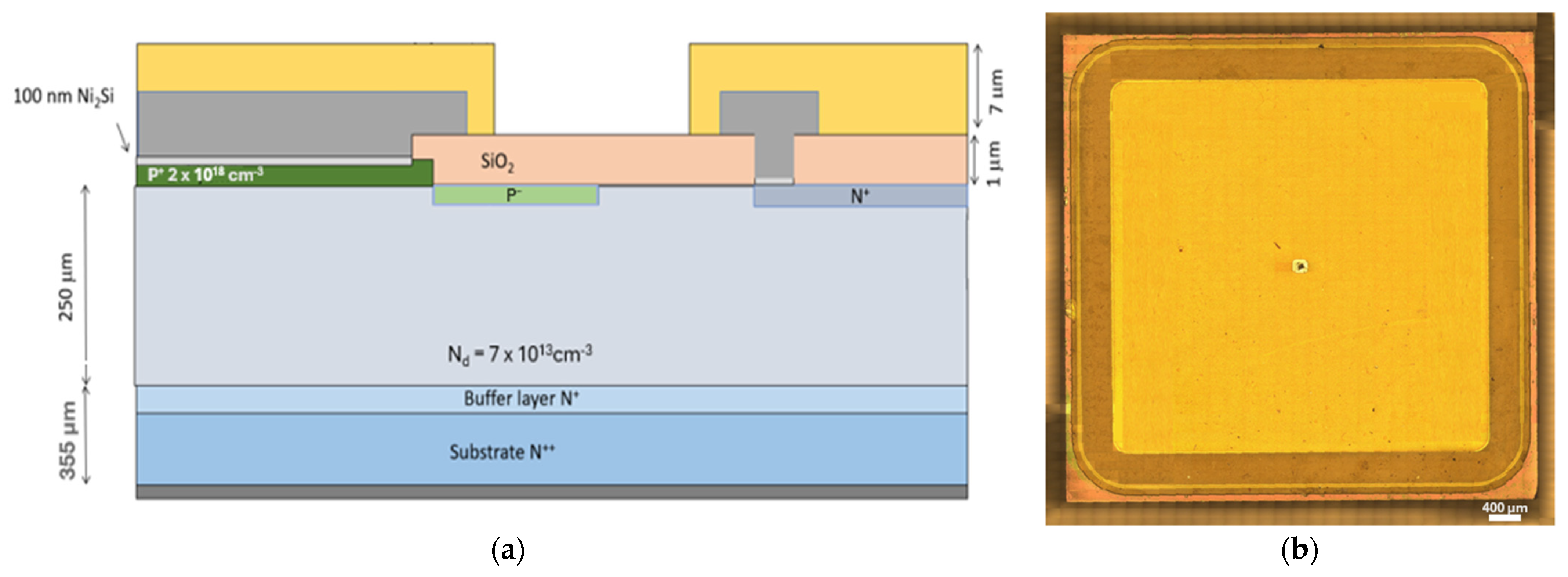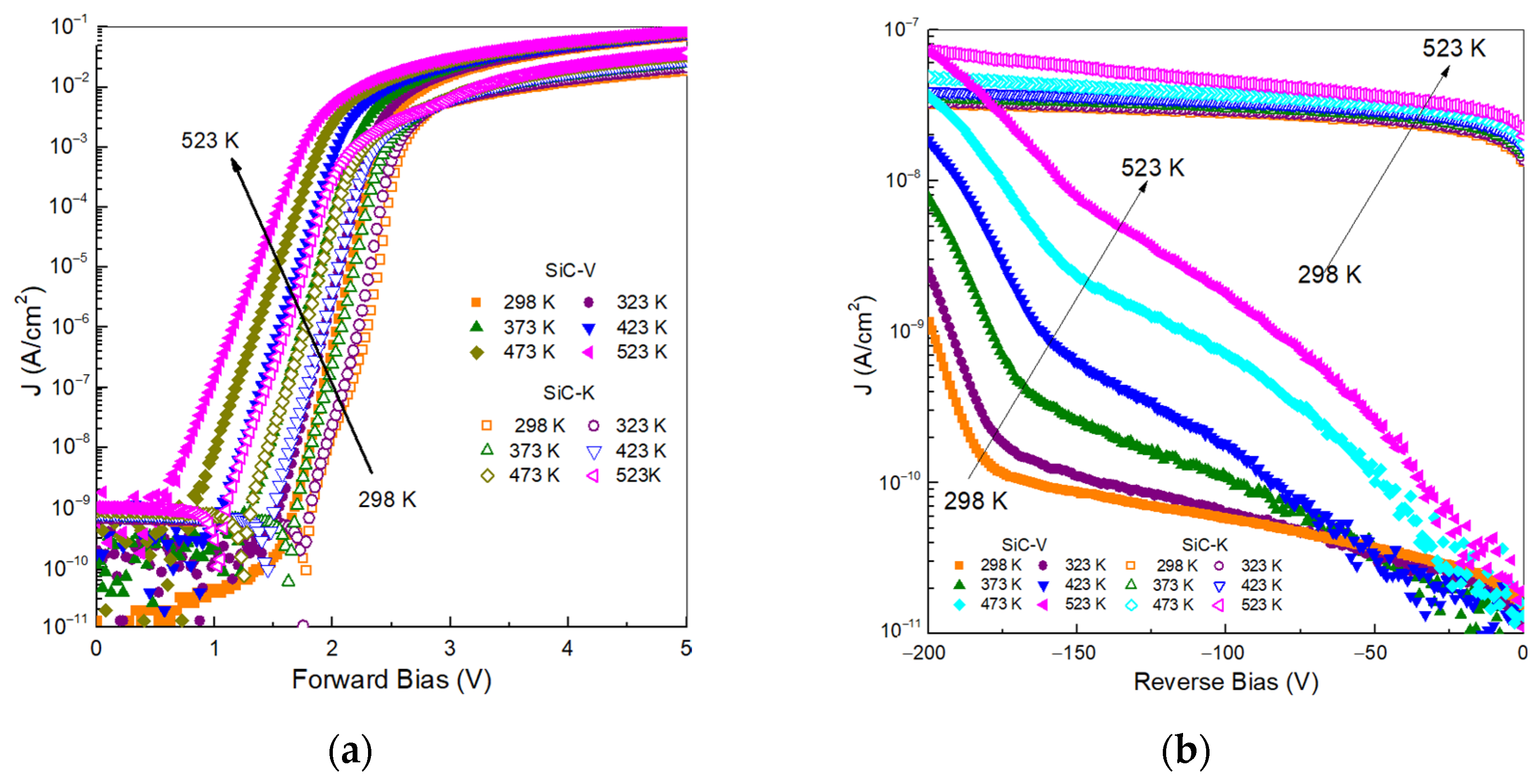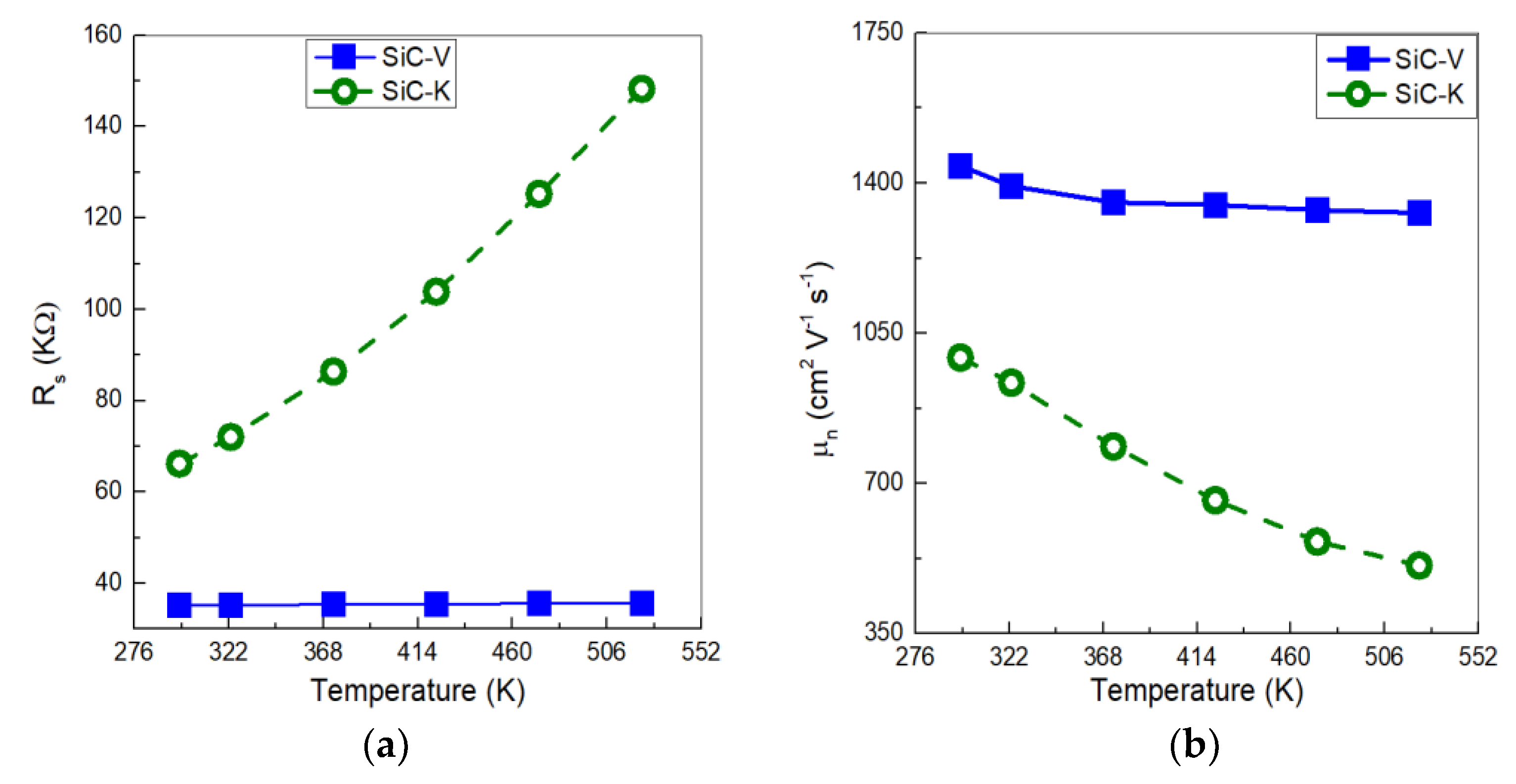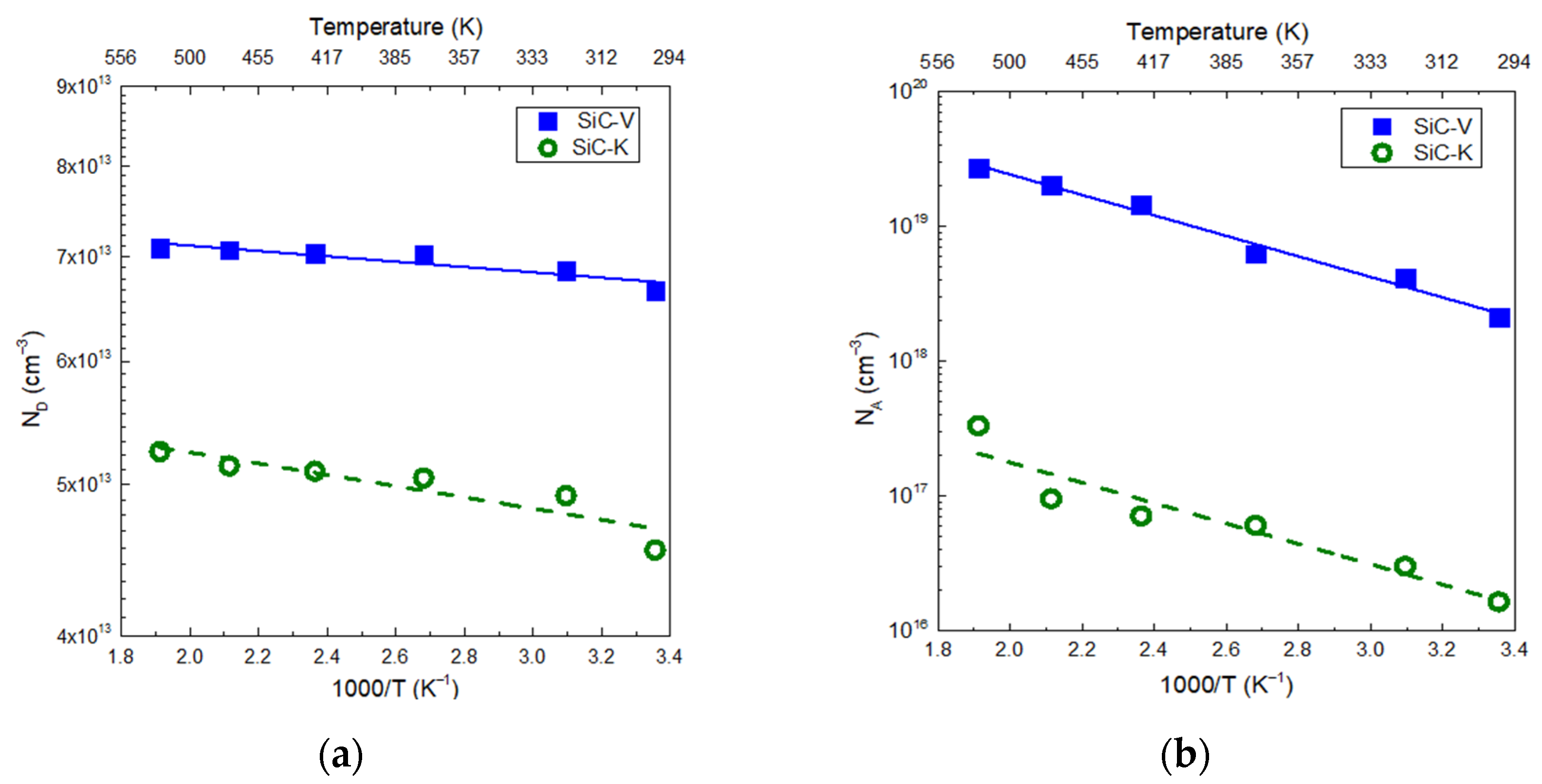Defects Induced by High-Temperature Neutron Irradiation in 250 µm-Thick 4H-SiC p-n Junction Detector
Abstract
1. Introduction
2. Materials and Methods
3. Results and Discussion
3.1. Electrical Characteristics of SiC Detectors
3.2. Deep Level Transient Spectroscopy
4. Conclusions
Author Contributions
Funding
Data Availability Statement
Conflicts of Interest
References
- Chuyanov, V.A. ITER Test Blanket Working Group Activities: A Summary, Recommendations and Conclusions. Fusion Eng. Des. 2002, 61–62, 273–281. [Google Scholar] [CrossRef]
- Mohamed, M.; Zakuan, N.D.; Tengku Hassan, T.N.A.; Lock, S.S.M.; Mohd Shariff, A. Global Development and Readiness of Nuclear Fusion Technology as the Alternative Source for Clean Energy Supply. Sustainability 2024, 16, 4089. [Google Scholar] [CrossRef]
- Rigamonti, D.; Dal Molin, A.; Muraro, A.; Rebai, M.; Giacomelli, L.; Gorini, G.; Nocente, M.; Cippo, E.; Conroy, S.; Ericsson, G.; et al. The Single Crystal Diamond-Based Diagnostic Suite of the JET Tokamak for 14 MeV Neutron Counting and Spectroscopy Measurements in DT Plasmas. Nucl. Fusion 2023, 64, 016016. [Google Scholar] [CrossRef]
- Angelone, M.; Verona, C. Properties of Diamond-Based Neutron Detectors Operated in Harsh Environments. J. Nucl. Eng. 2021, 2, 422–470. [Google Scholar] [CrossRef]
- Kushoro, M.H.; Angelone, M.; Bozzi, D.; Cancelli, S.; Dal Molin, A.; Gallo, E.; Gorini, G.; La Via, F.; Parisi, M.; Perelli Cippo, E. Operation of a 250 μm-Thick SiC Detector with DT Neutrons at High Temperatures. Fusion Eng. Des. 2024, 204, 114486. [Google Scholar] [CrossRef]
- La Via, F.; Camarda, M.; La Magna, A. Mechanisms of Growth and Defect Properties of Epitaxial SiC. Appl. Phys. Rev. 2014, 1, 031301. [Google Scholar] [CrossRef]
- Zang, Y.; Weber, W.J.; Jiang, W.; Wang, C.M.; Shutthanandan, V.; Hallèn, A. Effects of implantation temperature on damage accumulation in Al-implanted 4H–SiC. J. Appl. Phys. 2004, 95, 4012–4016. [Google Scholar] [CrossRef]
- Slotte, J.; Saarinen, K.; Janson, M.S.; Hallen, A.; Yu, A.; Kuznetsov, B.; Svensson, B.G.; Wong-Leung, J.; Jagadish, C. Fluence, flux, and implantation temperature dependence of ion-implantation-induced defect production in 4H–SiC. J. Appl. Phys. 2005, 97, 033513. [Google Scholar] [CrossRef]
- Wu, F.; Zhang, J.; Xi, W.; Chi, Y.Q.; Liu, Q.B.; Li, Y.; Ma, H.P.; Zhang, Q.C. Insights into the effects of Al-ion implantation temperature on material properties of 4H-SiC. Appl. Surf. Sci. 2023, 63, 156014. [Google Scholar] [CrossRef]
- Lucas, G.; Pizzagalli, L. Theoretical study of the recombination of Frenkel pairs in irradiated silicon carbide. Phys. Condens. Matter 2007, 19, 086208. [Google Scholar] [CrossRef][Green Version]
- Ruddy, F.H.; Mandal, K.C. A Review of the Effects of Fast-Neutron Irradiation on the Performance of 4H-SiC Schottky Barrier Detectors. IEEE Trans. Nucl. Sci. 2024, 71, 1056–1063. [Google Scholar] [CrossRef]
- Capan, I. Electrically Active Defects in 3C, 4H, and 6H Silicon Carbide Polytypes: A Review. Crystals 2025, 15, 255. [Google Scholar] [CrossRef]
- Sze, S.M.; Kwock, K.N. P-n Junctions in Physics of Semiconductor Devices, 3rd ed.; Wiley Interscience, John Wiley & Sons, Ltd.: Hoboken, NJ, USA, 2006; pp. 77–133. [Google Scholar]
- Kasap, S.O. Semiconductor Devices in Principles of Electronic Materials and Devices; McGraw-Hill Education: New York, NY, USA, 2017; pp. 548–550. [Google Scholar]
- Kimoto, T.; Cooper, J.A. Unipolar and Bipolar Power Diodes. In Fundamentals of Silicon Carbide Technology, 1st ed.; John Wiley & Sons: Hoboken, NJ, USA, 2014; pp. 294–296. [Google Scholar]
- Zimmermann, U.; Hallén, A.; Breitholtz, B. Current Voltage Characteristics of High-Voltage 4H Silicon Carbide Diodes. In Proceedings of the Silicon Carbide and Related Materials, Research Triangle Park, NC, USA, 10–15 October 2000. [Google Scholar]
- Park, J.; Park, B.G.; Baek, H.; Sun, G.M. Electrical Characteristics and Deep-Level Transient Spectroscopy of a Fast-Neutron-Irradiated 4H–SiC Schottky Barrier Diode. Nucl. Eng. Technol. 2023, 55, 201–208. [Google Scholar] [CrossRef]
- Liu, L.Y.; Shen, T.L.; Liu, A.; Zhang, T.; Bai, S.; Xu, S.R.; Jin, P.; Hao, Y.; Ouyang, X.P. Performance Degradation and Defect Characterization of Ni/4H-SiC Schottky Diode Neutron Detector in High Fluence Rate Neutron Irradiation. Diam. Relat. Mater. 2018, 88, 256–261. [Google Scholar] [CrossRef]
- Wang, X.; Qi, J.; Yang, M. Characterization of 600 V/650 V Commercial SiC Schottky Diodes at Extremely High Temperatures. In Proceedings of the 2019 IEEE 10th International Symposium on Power Electronics for Distributed Generation Systems (PEDG), Xi’an, China, 3–6 June 2019. [Google Scholar]
- Zhang, Y.; Wang, Z.; Xi, J.; Yang, J. Temperature-Dependent Band Gaps in Several Semiconductors: From the Role of Electron-Phonon Renormalization. J. Physics Condens. Matter 2020, 32, 475501–475508. [Google Scholar] [CrossRef] [PubMed]
- Long, Z.; Xia, X.; Jiang, W.; Jing, X.; Zou, X.; Shi, X.; Menghchen, N.; Liang, H.; Fan, R. Neutron irradiation and polarization effect of 4H–SiC Schottky detector. Nucl. Instrum. Methods Phys. Res. Sect. A 2024, 1064, 169326. [Google Scholar] [CrossRef]
- Raja, V.P.; Raynaud, C.; Asllani, B.; Morel, H.; Planson, D. Electrically Active Traps in 4H-Silicon Carbide (4H-SiC) PiN Power Diodes. J. Mater. Sci. Mater. Electron. 2023, 2023, 1383. [Google Scholar] [CrossRef]
- Trovato, G.; Meli, A.; Muoio, A.; Reitano, R.; Calcagno, L.; Kushoro, M.H.; Rebai, M.; Tardocchi, M.; Trotta, A.; Parisi, M.; et al. 250 µm Thick Detectors for Neutron Detection: Design, Electrical Characteristics, and Detector Performances. In Proceedings of the International Conference on Silicon Carbide and Related Materials, Conference Center, Sorrento, Italy, 17–22 September 2024. [Google Scholar]
- Li, H.; Wang, J.; Song, B.; Li, H.; Geng, L.; Duan, B.; Zhang, S. Mechanism of Electrical Performance Degradation of 4H-SiC Junction Barrier Schottky Diodes Induced by Neutron Irradiation. Nucl. Instrum. Methods Phys. Res. Sect. B 2024, 554, 165452. [Google Scholar] [CrossRef]
- Schroder, D.K. Series Resistance, Channel Lenght and Width, and Threshold Voltage. In Semiconductor Material and Device Characterization, 3rd ed.; IEEE Press: Piscataway, NJ, USA; Wiley: Hoboken, NJ, USA, 2006; pp. 190–191. [Google Scholar]
- Gsponer, A.; Gaggl, P.; Burin, J.; Thalmeier, R.; Waid, S.; Bergauer, T. Neutron Radiation Induced Effects in 4H-SiC PiN Diodes. J. Instrum. 2023, 18, C11027. [Google Scholar] [CrossRef]
- Hazdra, P.; Vobecký, J. Radiation Defects Created in N-Type 4H-SiC by Electron Irradiation in the Energy Range of 1–10 MeV. Phys. Status Solidi (A) 2019, 216, 1900312. [Google Scholar] [CrossRef]
- Moscatelli, F.; Scorzoni, A.; Poggi, A.; Passini, M.; Pizzocchero, G.; Nipoti, R. Effects of Very High Neutron Fluence Irradiation on P+n Junction 4H-SiC Diodes. In Proceedings of the Silicon Carbide and Related Materials, Newcastle upon Tyne, UK, 3–7 September 2006. [Google Scholar]
- Hazdra, P.; Záhlava, V.; Vobecky, J. Point Defects in 4H–SiC Epilayers Introduced by Neutron Irradiation. Nucl. Instrum. Methods Phys. Res. B 2014, 327, 124–127. [Google Scholar] [CrossRef]
- Liu, S.-S.; Zhang, H.-S.; Kang, F.-J.; Peng, Z.; Guo, S.-Q.; Lyu, J.; Gong, J. Identification and Passivation of D-Center in 4H-SiC: A First-Principles Study. Ann. Phys. 2024, 537, 2400317. [Google Scholar] [CrossRef]
- Dong, P.; Yan, X.; Zhang, L.; Jin, S.; Dai, F.; Zhanga, Y.; Cui, Y.; Yu, X.; Huang, B. Relating Gain Degradation to Defects Production in Neutron-Irradiated 4H-SiC Transistors. IEEE Trans. Nucl. Sci. 2021, 68, 312–317. [Google Scholar] [CrossRef]
- Tan, H.; Zhang, L.; Li, Z.; Li, J.T.; Dong, P. Impact of Neutron Radiation Induced Defects on the Surge Current Robustness of Silicon Carbide P-Intrinsic-N Diodes. Electron 2024, 3, e64. [Google Scholar] [CrossRef]
- Kleppinger, J.W. Epitaxial 4H-SiC Radiation Detectors for Harsh Environment Applications; Doctor of Philosophy in Electrical Engineering: South Carolina, SC, USA, 2022. [Google Scholar]
- Atabaev, I.G.; Juraev, K.N.; Hajiev, M.U. Spectral Dependence of Optical Absorption of 4H-SiC Doped with Boron and Aluminum. J. Spectrosc. 2018, 2018, 8705658. [Google Scholar] [CrossRef]
- Capan, I.; Brodar, T.; Coutinho, J.; Ohshima, T.; Markevich, V.; Peaker, A. Acceptor Levels of the Carbon Vacancy in 4H-SiC: Combining Laplace Deep Level Transient Spectroscopy with Density Functional Modeling. J. Appl. Phys. 2018, 124, 245701. [Google Scholar] [CrossRef]
- Coutinho, J.; Torres, V.J.B. Theory of the carbon vacancy in 4H-SiC: Crystal field and pseudo-Jahn-Teller effects. Phys. Rev. B 2017, 96, 174105. [Google Scholar] [CrossRef]
- Hornos, T.; Gali, A.; Svensson, B.G. Large-scale electronic structure calculations of vacancies in 4H-SiC using the Heyd-Scuseria-Ernzerhof screened hybrid density functional. In Proceedings of the Silicon Carbide and Related Materials, Sundvolden Conference Centre, Oslo, Norway, 29 August–2 September 2010. [Google Scholar]
- Pastuović, Ž.; Siegele, R.; Capan, I.; Brodar, T.; Sato, S.I.; Ohshima, T. Deep Level Defects in 4H-SiC Introduced by Ion Implantation: The Role of Single Ion Regime. J. Phys. Condens. Matter 2017, 29, 475701. [Google Scholar] [CrossRef]
- Pellegrino, D.; Calcagno, L.; Zimbone, M.; Di Franco, S.; Sciuto, A. Correlation between Defects and Electrical Performances of Ion-Irradiated 4H-SiC p-n Junctions. Materials 2021, 14, 1966. [Google Scholar] [CrossRef]
- Huang, Y.; Jiang, X.; Deng, T.; Yang, D.; Pi, X. Identifying the charge states of carbon vacancies in 4H-SiC by ab initio metadynamics. J. Appl. Phys. 2024, 135, 135701. [Google Scholar] [CrossRef]
- Burin, J.; Hahn, C.; Gaggl, P.; Gsponer, A.; Waid, S.; Bergauer, T. TCAD Simulations of Radiation Damage in 4H-SiC. In Proceedings of the Austrochip Workshop on Microelectronics (Austrochip), Vienna, Austria, 25–26 September 2024. [Google Scholar]
- Gaggl, P.; Burin, J.; Gsponer, A.; Waid, S.E.; Thalmeier, R.; Bergauer, T. TCAD Modeling of Radiation-Induced Defects in 4H-SiC Diodes. Nucl. Instrum. Methods Phys. Res. Sect. A 2025, 1070, 170015. [Google Scholar] [CrossRef]







| Sample | Z1/2 | RD1/2 | EH6/7 | ||||||
|---|---|---|---|---|---|---|---|---|---|
| ΔE (eV) | σ (cm−2) | (cm−3) | ΔE (eV) | σ (cm−2) | (cm−3) | ΔE (eV) | σ (cm−2) | (cm−3) | |
| SiC-V (Nd = 7E13 cm−3; CR = 121.55 pF) | 0.56 | 5.73 × 10−17 | 8.06 × 1013 | 0.93 | 5.88 × 10−15 | 1.54 × 1013 | 1.69 | 1.53 × 10−14 | 5.22 × 1013 |
| SiC-K (Nd = 6.7E13 cm−3; CR = 101.68 pF) | 0.67 | 2.72 × 10−15 | 1.34 × 1014 | 0.84 | 8.19 × 10−16 | 2.39 × 1013 | 1.52 | 2.00 × 10-15 | 9.23 × 1013 |
Disclaimer/Publisher’s Note: The statements, opinions and data contained in all publications are solely those of the individual author(s) and contributor(s) and not of MDPI and/or the editor(s). MDPI and/or the editor(s) disclaim responsibility for any injury to people or property resulting from any ideas, methods, instructions or products referred to in the content. |
© 2025 by the authors. Licensee MDPI, Basel, Switzerland. This article is an open access article distributed under the terms and conditions of the Creative Commons Attribution (CC BY) license (https://creativecommons.org/licenses/by/4.0/).
Share and Cite
Mancuso, A.S.; Sangregorio, E.; Muoio, A.; De Luca, S.; Kushoro, M.H.; Gallo, E.; Vanellone, S.; Quadrivi, E.; Trotta, A.; Calcagno, L.; et al. Defects Induced by High-Temperature Neutron Irradiation in 250 µm-Thick 4H-SiC p-n Junction Detector. Materials 2025, 18, 2413. https://doi.org/10.3390/ma18112413
Mancuso AS, Sangregorio E, Muoio A, De Luca S, Kushoro MH, Gallo E, Vanellone S, Quadrivi E, Trotta A, Calcagno L, et al. Defects Induced by High-Temperature Neutron Irradiation in 250 µm-Thick 4H-SiC p-n Junction Detector. Materials. 2025; 18(11):2413. https://doi.org/10.3390/ma18112413
Chicago/Turabian StyleMancuso, Alfio Samuele, Enrico Sangregorio, Annamaria Muoio, Saverio De Luca, Matteo Hakeem Kushoro, Erik Gallo, Silvia Vanellone, Eleonora Quadrivi, Antonio Trotta, Lucia Calcagno, and et al. 2025. "Defects Induced by High-Temperature Neutron Irradiation in 250 µm-Thick 4H-SiC p-n Junction Detector" Materials 18, no. 11: 2413. https://doi.org/10.3390/ma18112413
APA StyleMancuso, A. S., Sangregorio, E., Muoio, A., De Luca, S., Kushoro, M. H., Gallo, E., Vanellone, S., Quadrivi, E., Trotta, A., Calcagno, L., & Via, F. L. (2025). Defects Induced by High-Temperature Neutron Irradiation in 250 µm-Thick 4H-SiC p-n Junction Detector. Materials, 18(11), 2413. https://doi.org/10.3390/ma18112413








